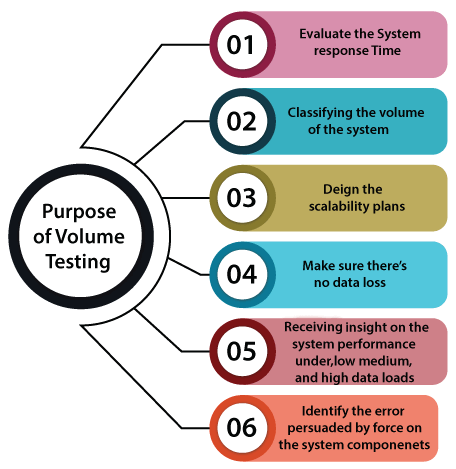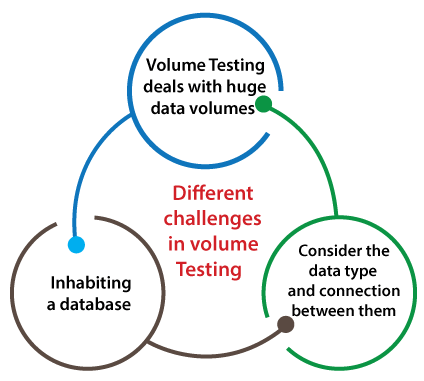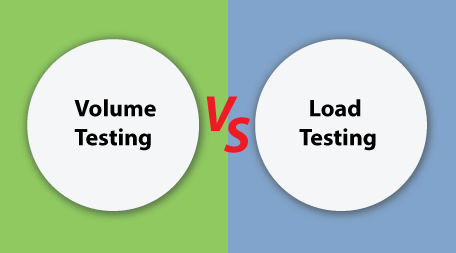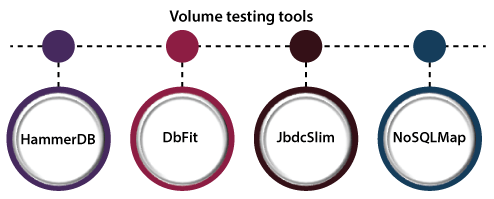Volume TestingIn this section, we are going to understand Volume testing, which helps us to check the behavior of an application by inserting a massive volume of the load in terms of data. And we also learn about its process, why we need to perform the volume testing, the objective of volume testing, multiple examples, various attributes of volume Testing, advantages, and disadvantages. Introduction of Volume TestingVolume testing comes under software testing. It helps us to check the behavior of an application by inserting a massive volume of the load in terms of data is known as volume testing. In volume testing, we will concentrate on the number of data rates than the number of users. It is also called Flood testing. It is executed to analyze the effect on the system's response time and behavior when the volume of data is enhancing in the database. In this testing, a massive volume of information is acted upon by the software. It is required to certify that the system is not at risk of overflow or data security issues. Note: Volume is a capacity while Load is a quantity, i.e., load testing means no. of users, and volume testing implies the amount of data.Purpose of Volume TestingThe initial objective of implementing the volume testing is to discover system performance with collective volumes of data in the database. Let see some other objectives of performing volume testing: 
We can evaluate the system response time as we know that the Volume testing is productive, and it helps the organization executives to confirm that software performance is not interrupted.
If we identify the system's volume, it helps us to simplifies the scalability development which is very useful while preparing the contingency plans. And the Volume testing gives understandings to developers, which helps them forecast how much data the system can proceed with without any failure. Design the scalability plans We can easily design the scalability plans by performing volume testing. As we learn that the volume tests help business executives understand if we enhance the size or accumulating more components to support the system.
In software testing, only through volume testing the project team can guarantee that there is no data loss as the burden on the system grows and the database's size.
The next objective of implementing the volume testing is to measures the system's performance under low and medium loads to ensure it works. And the risk of data loss is expanded under high data loads.
The purpose of doing the volume testing is to find issues that only display when the data load upsurges, higher response time, system failure, or security activities. Features of Volume TestingIt contains various features that are essential while executing the volume testing:
Why do we need the volume testing?Before we understand the need for volume testing, we will see one example of volume testing. Suppose there is an e-commerce web application, which is generally used by 1000 end-users. And during the sale or festive season, on the web application, around 40-50k users try to access the web application. And the application will crash, or the data could not load successfully, which cause problems for the customers. To overcome such real-time conditions, we need to perform one round of volume testing. The below aspects will help us to understand the importance of Volume testing:
What are the different challenges in Volume Testing?There are few things we always keep remember while executing the volume testing because all the initial thoughts in volume testing need to deal with data. 
As compared to other categories of performance testing, volume testing deals with huge data volumes. To handle a considerable amount of data it requires extensive data sets with a comprehensive team of test engineers. The programmer also has to deal with managing the data that bumped as an outcome of regular testing meetings.
It is the most commonly faced challenge during the volume testing because we are dealing with the relational databases, which contain a robust structure and lots of adjacent tables. And the tester needs to gather various fields, both the required elective ones that contain large binary files, to make sure the high quality of test data.
For the testing beginner, it is tough to learn the connections between them, the differences between the types, and how the software reacts. The test professionals have to deal with an extensive range of data valid, invalid, absent, boundary, or wrong during the volume testing. Difference between Volume Testing and Load TestingIn the below table, we have listed some of the vital distinction between volume testing and load testing: 
Volume testing toolsAs we know that the automation testing is a time-saving process and also provides the precise outcome as compared to manual testing. The primary advantage of using the volume testing tools is that we can execute the tests at night, and because of that, the team members or the other teams won't be affected by the data volume of the Database. Let see a few open-source tools compatible for volume testing:

HammerDbIt is an open-source tool and a database benchmarking application to the global database industry. It is used to automate, multi-threaded, and also allows run-time scripting. 
Features of HammerDB Following are the commonly used features of HammerDB:
DbFitThe DbFit is an open-source tool that supports the test-driven development. The DbFit tests can be used as existing executable documentation of our system behavior. Features of DbFit Some of the commonly used features of DbFit are as follows:
JdbcSlimAnother volume testing tool is JdbcSlim, where the database statements and queries are easily integrated into Slim FitNesse testing. It mainly emphasis keeping the configuration, test data, and SQL commands distinctly. Features of JdbcSlim Following are the commonly used features of JdbcSlim:
NoSQLMapThe NoSQLMap is an open-source Python tool, which is designed to automatically insert outbreaks and disrupt the Database configurations to evaluate the threat. Advantage of Volume testingSome benefits of volume testing are as follows:
Disadvantages of Volume TestingFollowing are the disadvantages of volume testing:
OverviewIn this tutorial, we will learn that volume testing is used to analyze the system performance for high data loads. It is a type of non-functional testing. The volume testing is executed manually as well as with the help of some automation tools to check the system performance. The volume testing is very important, which is relatively complicated with its challenges. Before implementing it, we need a complete knowledge of a particular concept along with the database languages. If any test beginner tries to perform the volume testing, they need to use some tool and perform some test case, which will help us understand the concept of volume testing before using it in real-time.
Next TopicScalability Testing
|
 For Videos Join Our Youtube Channel: Join Now
For Videos Join Our Youtube Channel: Join Now
Feedback
- Send your Feedback to [email protected]
Help Others, Please Share










